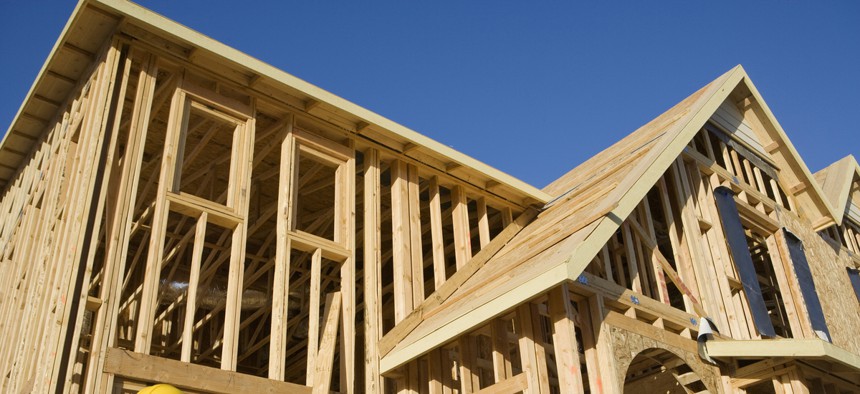Are McMansions Making Everyone Unhappy?

Shutterstock/sirtravelalot
Homes have gotten bigger, but Americans aren’t any more pleased with the extra space.
American homes are a lot bigger than they used to be. In 1973, when the Census Bureau started tracking home sizes, the median size of a newly built house was just over 1,500 square feet; that figure reached nearly 2,500 square feet in 2015.
This rise, combined with a drop in the average number of people per household, has translated to a whole lot more room for homeowners and their families: By one estimate, each newly built house had an average of 507 square feet per resident in 1973, and nearly twice that—971 square feet—four decades later.
But according to a recent paper, Americans aren’t getting any happier with their ever bigger homes. “Despite a major upscaling of single-family houses since 1980,” writes Clément Bellet, a postdoctoral fellow at the European business school INSEAD, “house satisfaction has remained steady in American suburbs.”
This finding, Bellet reasons, has to do with how people compare their houses with others in their neighborhood—particularly the biggest ones. In his paper, which is currently under peer review, he looks closely at the construction of homes that are larger than at least 90 percent of the other houses in the neighborhood. By his calculation, if homes in the 90th percentile were 10 percent bigger, the neighbors would be less pleased with their own homes unless those homes grew 10 percent as well. Moreover, the homeowners most sensitive to such shifts are the ones whose houses are in the second-biggest tier, not the ones whose houses are median-sized.
To be clear, having more space does generally lead to people saying they’re more pleased with their home. The problem is that the satisfaction often doesn’t last if even bigger homes pop up nearby. “If I bought a house to feel like I'm ‘the king of my neighborhood,’ but a new king arises, it makes me feel very bad about my house,” Bellet wrote to me in an email.
The largest houses seem to be the ones that all the other homeowners base their expectations on. In neighborhoods where the biggest houses are more modest, Bellet told me, expanding the size of one’s house can be 10 times as satisfying as undertaking such an expansion in a neighborhood where the biggest homes are palatial.
Bellet sketches out an unfulfilling cycle of one-upmanship, in which the owners of the biggest homes are most satisfied if their home remains among the biggest, and those who rank right below them grow less satisfied as their dwelling looks ever more measly by comparison. He estimates that from 1980 to 2009, the size of the largest 10 percent of houses increased 1.4 times as fast as did the size of the median house. This means that the reference point many people have for what constitutes a big home has shifted further out of reach, just as many other lifestyle reference points have shifted in an age of pronounced wealth inequality.
To reach these conclusions, Bellet scraped data on millions of American homes from the real-estate website Zillow, and grafted it onto data from the American Housing Survey, which has been conducted by the Census Bureau since 1973 and records, among other things, how big new homes are and how satisfied homeowners are with their houses. The merging of these two sources allowed Bellet to examine how envy might play out on the level of the neighborhood block, and to study, for instance, whether being close to an enormous new house makes one less satisfied with one’s own home. (It appears to.)
Bellet was looking in particular at the links between the size of one’s home and one’s satisfaction with it. But it could well be the case that having a bigger home is beneficial in ways he wasn’t focusing on. “There could be positive impacts on, say, long-run life satisfaction more generally if McMansion neighborhoods also have better schools, which improves the future outcomes of homeowners’ kids,” Bellet wrote to me.
Of course, expansive homes could be unfulfilling in other ways. “The big house represents the atomizing of the American family,” a historian of landscape development told NPR for a story on gargantuan American homes back in 2006. “Each person not only has his or her own television—each person has his or her own bathroom … This way, the family members rarely have to interact.” It’s comfortable, in a way, but maybe also lonely.
In this sense, the story of American home sizes in the past half century is a story of shifting norms. Fifty-plus years ago, a one-bathroom house or a bedroom that slept multiple siblings might have felt cramped—but it also probably felt normal. Today, many Americans can afford more space, and they’ve bought it. They just don’t appear to be any happier with it than with what they had before.
Joe Pinsker is a staff writer at The Atlantic.
NEXT STORY: Coaxing Veterans Into Treatment to Prevent Suicides





